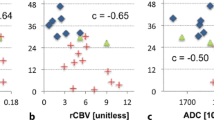Abstract
Introduction
The presence of adhesions between the brain and the meningioma is an important factor that determines the success of total surgical removal. Brain surface motion imaging enables assessment of the dynamics of brain surface motion. A subtraction image of pulse-gated heavily T2-weighted images in different phases of the cardiac cycle provides a stripe pattern on the surface of the pulsating brain. Thus, the lack of a stripe pattern on the surface of extraaxial tumor indicates the presence of tumor–brain adhesion. The purpose of the present experiment was to evaluate the accuracy of predicting tumor–brain adhesion using the original double acquisition method and the improved single acquisition method.
Methods
The subjects were 67 meningioma cases patients who were surgically treated after brain surface motion imaging. Thirty-three cases were evaluated using the double acquisition method and 34 cases were evaluated with the single acquisition method. In the double acquisition method, the two sets of images are acquired as two independent scans, and in the single acquisition method, the images are acquired serially as a single scan.
Results
The findings for the double acquisition method agreed with the surgical findings in 23 cases (69.7 %), while findings from the single acquisition method agreed with the surgical findings in 26 cases (76.5 %).
Conclusion
Pre-surgical evaluation for tumor–brain adhesion by brain surface motion imaging provides helpful information for meningioma surgery, especially when using the single acquisition method.





Similar content being viewed by others
References
Sindou MP, Alaywan M (1998) Most intracranial meningiomas are not cleavable tumors: anatomic–surgical evidence and angiographic predictability. Neurosurgery 42(3):476–480
Salpietro FM, Alafaci C, Lucerna S, Iacopino DG, Todaro C, Tomasello F (1994) Peritumoral edema in meningiomas: microsurgical observations of different brain tumor interfaces related to computed tomography. Neurosurgery 35(4):638–641, discussion 641–632
Taoka T, Yamada S, Yamatani Y, Akashi T, Miyasaka T, Emura T, Nakase H, Kichikawa K (2010) Brain surface motion imaging to predict adhesions between meningiomas and the brain surface. Neuroradiology 52(11):1003–1010. doi:10.1007/s00234-010-0671-z
Ildan F, Tuna M, Gocer AP, Boyar B, Bagdatoglu H, Sen O, Haciyakupoglu S, Burgut HR (1999) Correlation of the relationships of brain–tumor interfaces, magnetic resonance imaging, and angiographic findings to predict cleavage of meningiomas. J Neurosurg 91(3):384–390
Nakasu S, Nakasu Y, Matsumura K, Matsuda M, Handa J (1990) Interface between the meningioma and the brain on magnetic resonance imaging. Surg Neurol 33(2):105–116
Spagnoli MV, Goldberg HI, Grossman RI, Bilaniuk LT, Gomori JM, Hackney DB, Zimmerman RA (1986) Intracranial meningiomas: high-field MR imaging. Radiology 161(2):369–375
Takeguchi T, Miki H, Shimizu T, Kikuchi K, Mochizuki T, Ohue S, Ohnishi T (2003) Prediction of tumor–brain adhesion in intracranial meningiomas by MR imaging and DSA. Magn Reson Med Sci 2(4):171–179
Takeguchi T, Miki H, Shimizu T, Kikuchi K, Mochizuki T, Ohue S, Ohnishi T (2003) Evaluation of the tumor–brain interface of intracranial meningiomas on MR imaging including FLAIR images. Magn Reson Med Sci 2(4):165–169
Kalkanis SN, Carroll RS, Zhang J, Zamani AA, Black PM (1996) Correlation of vascular endothelial growth factor messenger RNA expression with peritumoral vasogenic cerebral edema in meningiomas. J Neurosurg 85(6):1095–1101
Inamura T, Nishio S, Takeshita I, Fujiwara S, Fukui M (1992) Peritumoral brain edema in meningiomas—influence of vascular supply on its development. Neurosurgery 31(2):179–185
Tamiya T, Ono Y, Matsumoto K, Ohmoto T (2001) Peritumoral brain edema in intracranial meningiomas: effects of radiological and histological factors. Neurosurgery 49(5):1046–1051, discussion 1051–1042
Lee KJ, Joo WI, Rha HK, Park HK, Chough JK, Hong YK, Park CK (2008) Peritumoral brain edema in meningiomas: correlations between magnetic resonance imaging, angiography, and pathology. Surgical Neurology 69(4):350–355, discussion 355. doi:10.1016/j.surneu.2007.03.027
Yamamoto J, Kakeda S, Takahashi M, Aoyama Y, Soejima Y, Saito T, Akiba D, Korogi Y, Nishizawa S (2011) Dural attachment of intracranial meningiomas: evaluation with contrast-enhanced three-dimensional fast imaging with steady-state acquisition (FIESTA) at 3T. Neuroradiology 53(6):413–423. doi:10.1007/s00234-010-0751-0
Baumert B, Wortler K, Steffinger D, Schmidt GP, Reiser MF, Baur-Melnyk A (2009) Assessment of the internal craniocervical ligaments with a new magnetic resonance imaging sequence: three-dimensional turbo spin echo with variable flip-angle distribution (SPACE). Magn Reson Imaging 27(7):954–960. doi:10.1016/j.mri.2009.01.012
Watanabe Y, Makidono A, Nakamura M, Saida Y (2011) 3D MR cisternography to identify distal dural rings: comparison of 3D-CISS and 3D-SPACE sequences. Magn Reson Med Sci 10(1):29–32
Conflict of interest
Masato Uchikoshi works for Siemens Japan KK (Tokyo, Japan). He made improvements to the imaging sequences for the single acquisition method but did not participate in the image evaluation.
Author information
Authors and Affiliations
Corresponding author
Rights and permissions
About this article
Cite this article
Taoka, T., Yamada, S., Sakamoto, M. et al. Accuracy for predicting adhesion between meningioma and the brain by using brain surface motion imaging: comparison between single and double acquisition methods. Neuroradiology 54, 1313–1320 (2012). https://doi.org/10.1007/s00234-012-1054-4
Received:
Accepted:
Published:
Issue Date:
DOI: https://doi.org/10.1007/s00234-012-1054-4




